By now, we are all very well aware that Costa Rica is famous for its beautiful landscapes and its rich biodiversity, but more than anything, it values its coffee. Costa Rica has the best coffee producers in the world and is well respected due to the outstanding quality and taste that oozes from the drink.
For coffee enthusiasts wondering about the best time of year to visit Costa Rica, aligning your trip with the coffee harvest season can offer a richer experience.
But unlike in many places, here it is respected as something more than a hot drink. It is an important part of Costa Rican culture and economy, and it is done daily. The journey of coffee from plantation to cup is a meticulous process. A look into the process will show you why this beverage is beloved.

The Coffee Plantations
Its distinct geography—volcanic soil and a mixed climatic profile—provides ideal grounds for coffee cultivation. Some of the most associated areas with the growing of the very top–grade coffee beans are Central Valley, Tarrazú, and Monteverde.
The cool temperature and high altitude in these areas give the characteristic flavors of Costa Rican coffee. The visitor can visit many coffee plantations, including the Hacienda Espíritu Santo and Doka Estate, and learn about dedication and knowledge in growing this plant.
The Harvesting Process
The coffee harvesting season usually occurs between November and March, which is often considered the best time of year to visit Costa Rica for those looking to witness this vibrant process. That is a very active and exciting moment at the plantations when laborers handpick ripe coffee cherries.
It can be very trying, as picking requires skills and precision to pick only cherries ripening at their pick. The great care put into the picking will guarantee that coffee beans are top and consistent in quality, hence attributing to the great taste of Costa Rican coffee.
From Cherry to Bean
When ripe, the journey from the cherry to the bean starts. The coffee cherries can be processed in two ways: wet or dry. In the wet method, the cherries are pulped, fermented, and washed to get rid of the outer layers of the fruits, leaving the beans.
The cherries are laid in the sun for drying, and the outer layers are discarded. Each of these methods gives the coffee its particular taste and flavor profile. For instance, wet processing, generally related to a clear and bright taste, can be different from dry processing, with a more rounded, complex flavor.
Roasting the Beans
Roasting is a critical step that transforms green coffee beans into aromatic, flavorful beans ready for brewing. The roasting process involves carefully controlled heat to produce the beans’ natural oils and flavors.
Light roasts preserve more of the bean’s original characteristics, while darker roasts develop more profound, robust flavors. Costa Rican roasters are known for their skill in achieving the perfect roast to highlight the unique qualities of their coffee beans.
From Bean to Cup
In Costa Rica, brewing coffee is an art form. One traditional method is the chorreador, a simple yet effective device that uses a cloth filter suspended over a wooden stand. Hot water is poured over ground coffee in the filter, allowing the brewed coffee to drip into a cup below. This method is cherished for its ability to produce a smooth, flavorful cup of coffee. Whether enjoyed black or with a splash of milk, Costa Rican coffee is a delightful experience that reflects the country’s dedication to quality and tradition.
Costa Rica Coffee Trail: Plantation to Cup Journey

From the lush coffee plantations to the final sip in your cup, Costa Rica’s coffee trail is a captivating journey. Each step of the process, from harvesting to roasting, showcases the passion and expertise of Costa Rican coffee producers. Exploring this trail offers not just a taste of world-class coffee but also an appreciation for the rich cultural heritage behind it. Villa Firenze is an all-inclusive Villa in Costa Rica that is a great place to stay when you want to go on a coffee tour.
So, next time you savor a cup of Costa Rican coffee, remember the incredible journey it will take to reach you, and consider embarking on your adventure along Costa Rica’s enchanting coffee trail.

Jessi is the creative mind behind The Coffee Mom, a popular blog that combines parenting advice, travel tips, and a love for all things Disney. As a trusted Disney influencer and passionate storyteller, Jessi’s authentic insights and relatable content resonate with readers worldwide.
